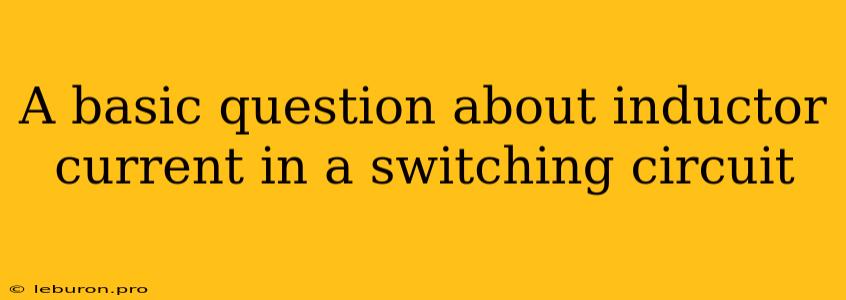Understanding the behavior of inductor current in a switching circuit is crucial for designing and analyzing power electronics circuits. Inductors, due to their inherent property of resisting changes in current, play a vital role in shaping the current flow within these circuits. This article aims to delve into the fundamentals of inductor current behavior in switching circuits, addressing common questions and providing insights into the underlying principles.
The Essence of Inductor Current
An inductor, essentially a coil of wire, stores energy in a magnetic field when current flows through it. The key characteristic of an inductor is its opposition to changes in current flow. This opposition is quantified by its inductance, measured in Henries (H). The fundamental relationship governing inductor behavior is given by:
V = L(di/dt)
Where:
- V is the voltage across the inductor
- L is the inductance of the inductor
- di/dt is the rate of change of current through the inductor
This equation reveals that the voltage across an inductor is directly proportional to the rate of change of current. If the current is constant, the voltage across the inductor is zero. However, if the current changes rapidly, the voltage across the inductor becomes significant.
Inductor Current in Switching Circuits
Switching circuits, as the name suggests, involve rapid switching of components, often transistors or diodes. This rapid switching creates sudden changes in current flow, making the behavior of inductors crucial to understand.
Inductor Current During On-State
When the switch in a switching circuit is closed, the inductor begins to store energy. The current through the inductor will increase linearly as long as the voltage across it remains constant. The rate of increase in current is determined by the inductance and the voltage across the inductor.
Example: Consider a simple circuit with a 10V DC source, a switch, and a 10mH inductor. When the switch is closed, the voltage across the inductor is 10V. The rate of change of current is:
di/dt = V/L = 10V/10mH = 1A/ms
This means the current through the inductor increases at a rate of 1 Ampere every millisecond.
Inductor Current During Off-State
When the switch opens, the current path through the inductor is interrupted. Due to the inductor's inherent property of resisting current change, the current cannot instantly drop to zero. Instead, the inductor releases its stored energy, causing the current to flow through an alternative path. This path is usually provided by a diode, a freewheeling diode, or another component designed to handle the current during the off-state.
Key Points
- Continuity of Current: Inductor current cannot change instantaneously. It must ramp up or down gradually.
- Energy Storage and Release: Inductors store energy in a magnetic field during the on-state and release this energy during the off-state.
- Current Direction: The direction of inductor current during the off-state is opposite to the direction during the on-state.
Practical Applications
The behavior of inductor current in switching circuits finds extensive applications in various power electronics circuits:
- DC-DC Converters: In DC-DC converters, inductors are used to smooth out the ripple in the output voltage. The inductor's ability to store energy during the on-state and release it during the off-state helps maintain a relatively constant output voltage.
- Inverters: Inverters use inductors to shape the current waveform and create an alternating current output from a DC input. The inductor's ability to resist changes in current plays a crucial role in this conversion process.
- Motor Control: In motor control circuits, inductors are used to limit the current flow during starting and braking, protecting the motor from damage.
- Filters: In power supplies and other applications, inductors are used as filters to eliminate unwanted frequencies from the signal. Their ability to block high-frequency components makes them ideal for filtering purposes.
Conclusion
Understanding the behavior of inductor current in a switching circuit is essential for designing and analyzing power electronics systems. Inductors, with their unique property of opposing current changes, play a pivotal role in shaping the current flow in these circuits. Their ability to store and release energy, coupled with their inherent current continuity, makes them indispensable components in various power electronics applications. By grasping the fundamental principles and practical applications of inductor current in switching circuits, engineers can effectively harness the power of these devices for various tasks.
